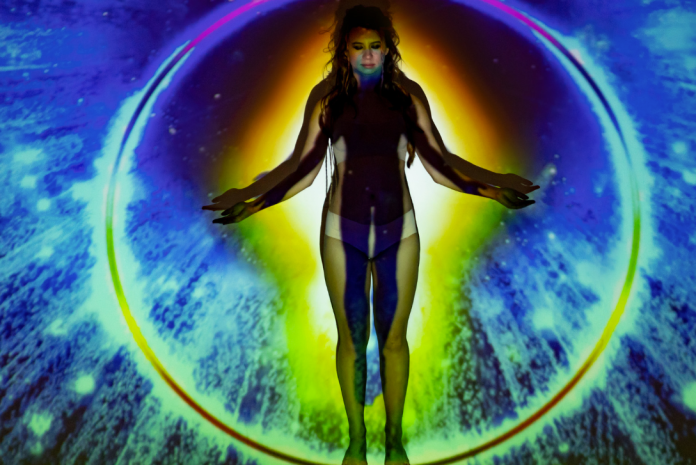Everyone has an aura, the colored vibration that emits from people every second of every day. One way to view it is as a psychic field that reflects one’s physical health, chakras, or mood. It also reflects one’s future and past, and aura-sensitive individuals are the ones who can pick up on these colors.
- Red refers to the heart and the circulatory system. Positive red is a healthy ego, but negative red reflects anxiety, anger, and a lack of forgiveness.
- Deep red reflects a person who is realistic, grounded, and strong-willed.
- Muddy red reflects anger.
- Clear red reflects sensuality, energy, competition, passion, and power.
- Orange red reflects confidence.
- Bright pink reflects clairaudience, compassion, sensitivity, love, affection, and sensuality (with an artistic streak).
- Dark muddy pink reflects immaturity and dishonesty.
- Orange can be interpreted as a reading of one’s emotional health (as well as one’s reproductive organs). Those with orange auras show excitement and vitality. Viewed positively, it can mean one is courageous, sociable, and creative, whereas if an orange aura is viewed negatively, it can indicate addiction and stress.
- Brownish orange indicates emotional repression and a lazy streak, whereas orange yellow indicates perfectionism, creativity, attention to detail, and overall intelligence.
- Yellow represents an individual’s life energy (while also referring to the spleen). A person with a yellow aura can be interpreted as intelligent, inspired, easygoing, optimistic, and awakened.
- Dark, Muddy Yellow-Gold represents an overwhelmed person, but clear, metallic gold suggests a spiritually active person.
- Bright yellow represents a person who is terrified of losing power, respect, and control, and pale yellow represents positivity, hope, and optimism.
- Green refers to the respiratory system and indicates comfortable, healthy energy. It suggests change, growth, balance, and a love of other people.
- Muddy forest green refers to a propensity for blaming others and jealousy and insecurity; yellow green refers to creativity and clear communication, and emerald green refers to a loving person who can be considered a healer.
- The turquoise aura reflects the immune system’s health while suggesting that a person is compassionate and sensitive.
- The blue aura reflects the health of the thyroid and throat. It also suggests that a person is caring, calm, and intuitive.
- Muddy blue suggests a fear of speaking the truth; royal blue suggests spiritualism, generosity, and clairvoyance; and light blue suggests truthfulness, clarity, and peacefulness.
- Indigo aura reflects the health of the pituitary gland. It also suggests that a person is capable of deep feeling.
- Violet aura reflects the health of the nervous system and pineal gland. It also suggests a magical, artistic, and/or psychic person.
- Lavender aura suggests a daydreamer with an active imagination.
- The silver aura reflects spiritual abundance. It also suggests that a person is expected to encounter money soon.
- Bright, metallic silver denotes intuition and nurturing; muddy gray denotes fear and indicates illness in whatever area of the body it is seen, and dirty gray denotes skepticism.
- The gold aura reflects a person’s state of enlightenment. It also suggests that a person is in touch with their divine guide, intuition, and inner peace.
- The black aura reflects the transformation of energy. It also suggests that a person is unforgiving or suffering from grief and/or trauma from their past life.
- The white aura reflects the protection of certain energies. It also suggests that a person is experiencing new energy and has truthful angelic qualities. Flashes of white auras indicate the nearness of angels.
- A dirty, grayish-white aura potentially indicates illness.
- Earth tones reflect a person who works outside; they are good, grounding colors.
- A rainbow aura reflects the presence of a healer.
- Pastel auras reflect a need for serenity.
- Brown aura indicates a person who is self-obsessed and greedy, whereas dirty brown reflects insecurity and negative energy.
Auras can change colors often, and our surroundings or moods can affect these changes. Have your aura read or learn to see your own to make sure it is healthy.


I appreciate the comprehensive breakdown of each aura color and its meaning. Understanding these nuances could potentially be quite useful in areas like holistic health and personal development.
While the concept of auras is fascinating, I wonder how widely accepted these interpretations are within the broader spiritual and metaphysical communities. Are there varying schools of thought on this topic?
The detailed correlations between aura colors and various aspects of health and personality are intriguing. It would be interesting to see if there’s any scientific research that supports these observations.
The recommendation to have one’s aura read or to learn to see it oneself is interesting. It makes me curious about the training and skills required to accurately interpret auras.
The idea that aura colors can reflect not just current health and emotions but also one’s past and future is quite compelling. It raises a lot of questions about the mechanisms behind such phenomena.